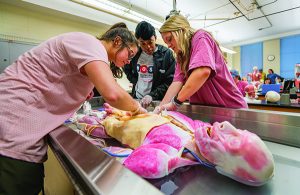 Human Anatomy was developed as an upper-division course that fulfills the increasingly common requirement of professional school programs for students to successfully complete a human anatomy course prior to enrollment. The course satisfies the upper-division credit requirements students need, decreases costs, and expedites graduation times.
Human Anatomy was developed as an upper-division course that fulfills the increasingly common requirement of professional school programs for students to successfully complete a human anatomy course prior to enrollment. The course satisfies the upper-division credit requirements students need, decreases costs, and expedites graduation times.
The availability of SynDaver as well as cadaver prosections and 3D visualization software provide students with the opportunity to study human anatomy as part of their biology degree program.
“As a student beginning a physical therapy doctoral program in the fall, taking an upper-level anatomy course was a necessary prerequisite and something I believe will prepare me for my field of study. I was not disappointed.
One of the main assets of this course is the laboratory component, in which students have access to three main groups of resources to explore each lab session: the SynDaver, the plastinated cadaver prosections, and the 3D anatomy software. The variety of resources allows students an experience in human anatomy unmatched by many schools. The variety of resources allowed me to gain a deeper understanding of each body system by analyzing individual parts of the body many times, and in different ways and contexts. The specimens I studied the most were the plastinates, in part because of the fascinating level of detail visible in each, and because you look at anatomical structures from a new perspective. Many times I thought I knew where a certain anatomical structure was located on the SynDaver, but upon investigation of the plastinated sections, I found that my mental 3D image of the structure was skewed. Being able to find the same structure repeatedly throughout the lab is an invaluable resource to understand the structure of the human body.

Monica Stacy, a senior from Memphis, with a double major in biology and Spanish, will enter the Doctor of Physical Therapy program at the University of Tennessee Health Sciences Center after her May 2020 graduation.
This course prepared me for graduate school because, frankly, anatomy is hard. The human body is incredibly complex, and to expect to learn every minute detail of every system in perfect detail in a single semester is unrealistic. I now have an incredible base of anatomical knowledge, thanks to this course. It tested me as a student in the best way possible and has prepared me for what I should expect when I enter gross anatomy lab as a first-year physical therapy student!”
“Having been raised in Hattiesburg, I often hear, ‘why Ole Miss, and not USM?’ My love for the Ole Miss campus, coupled with my lifelong goal of becoming a physician, pointed me to Oxford.
Our biology program does a great job of exposing students to several of the various biological studies, ranging from ecology and virology, to marine biology or evolution. My personal favorites are those relating to human anatomy and physiology, both healthily and pathologically speaking.
As one of the first students to take Bisc 310, the new Human Anatomy class, I knew it would be challenging, but I also knew that if I were to attend medical school, having anatomical foundation would be worth it.
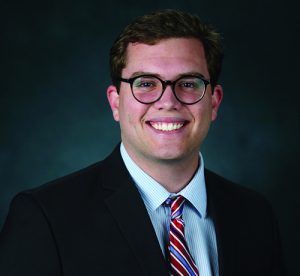
Grant Wichman, a 2019 graduate, will enter the University of Mississippi Medical Center School of Medicine in August. He currently works as a research associate with Dr. Wayne Gray on vaccine development.
I had taken Bisc 330 (Introductory Physiology) with Professor Carol Britson the previous year, and I really enjoyed her teaching style. Pre-reading and assignments outside of class prepared me for tests and allowed for better retention throughout the semester. Dr. Britson did a phenomenal job teaching us how to learn and how to study on top of the material given in class. I figured Anatomy would be similar and decided to take it.
Regarding the lab, I feel a lot more confident at tackling lengthy and complex lab practicals that are soon to come my way. Though I appreciated the privilege of having Gloria, our SynDaver, my favorite specimens were the plastinated cross sections. There is something oddly satisfying about learning and being able to successfully identify bones, organs, or muscles viewed from their most abnormal perspectives. Having Gloria as a full-size specimen paired with enlarged, transected, or digital specimen allows for a holistic way to learn about each organ/system at different structural levels.
Though I will have a year or so between Bisc 310 and when I will take Gross Anatomy, I know that if I can retain even a little of what I learned in 310 (materially and strategically), I’ll be prepared for success in medical school.”
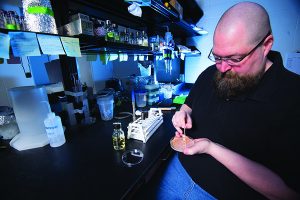
 Launched in the summer of 2015 by Professor Erik Hom, ARISE@UM is the first unified umbrella program to offer Mississippi high school students the opportunity to pursue faculty-mentored research experiences in STEM departments across campus.
Launched in the summer of 2015 by Professor Erik Hom, ARISE@UM is the first unified umbrella program to offer Mississippi high school students the opportunity to pursue faculty-mentored research experiences in STEM departments across campus. Human Anatomy was developed as an upper-division course that fulfills the increasingly common requirement of professional school programs for students to successfully complete a human anatomy course prior to enrollment. The course satisfies the upper-division credit requirements students need, decreases costs, and expedites graduation times.
Human Anatomy was developed as an upper-division course that fulfills the increasingly common requirement of professional school programs for students to successfully complete a human anatomy course prior to enrollment. The course satisfies the upper-division credit requirements students need, decreases costs, and expedites graduation times.

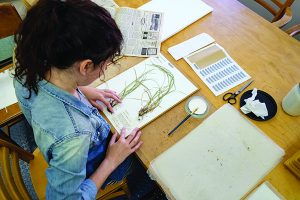 An herbarium is a museum collection of plants and the information from where and when they were collected. This collection is used in teaching and in research to document changes in plant distribution through time.
An herbarium is a museum collection of plants and the information from where and when they were collected. This collection is used in teaching and in research to document changes in plant distribution through time.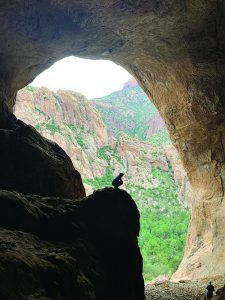
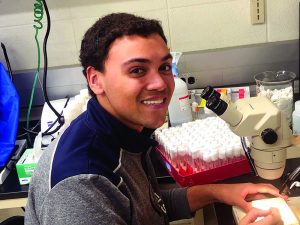 An underlying contributor to many forms of drug addiction are genetic variants responsible for high levels of “novelty-seeking” behavior. This personality trait is associated with dangerous and compulsive behavior, including using drugs of abuse. Identifying the genetic basis for differences in novelty-seeking will give us the necessary insight to understand the underlying neurobiology and may provide us with fresh ideas into why some people are likely to abuse drugs and are also more likely to relapse.
An underlying contributor to many forms of drug addiction are genetic variants responsible for high levels of “novelty-seeking” behavior. This personality trait is associated with dangerous and compulsive behavior, including using drugs of abuse. Identifying the genetic basis for differences in novelty-seeking will give us the necessary insight to understand the underlying neurobiology and may provide us with fresh ideas into why some people are likely to abuse drugs and are also more likely to relapse. JP Lawrence, a recent graduate of the PhD program in biology at the University of Mississippi, made international headlines when the results of his UM-based graduate research were published in the Proceedings of the National Academy of Sciences.
JP Lawrence, a recent graduate of the PhD program in biology at the University of Mississippi, made international headlines when the results of his UM-based graduate research were published in the Proceedings of the National Academy of Sciences.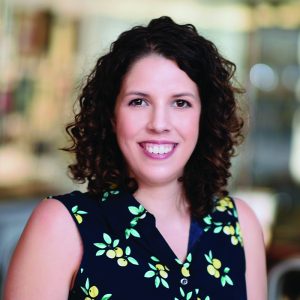 Why did you study biology?
Why did you study biology? 